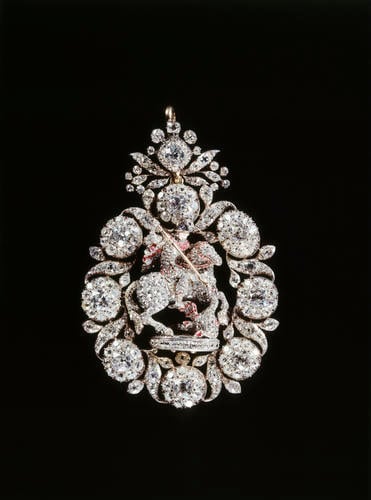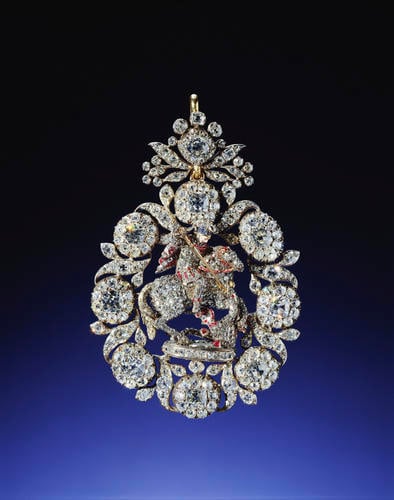Lesser George before 1750?
Gold, diamond, sapphire, ruby, amethyst | 11.6 x 7.8 cm (whole object) | RCIN 441145
-
Lesser George of gold, jewelled all over, mainly with diamonds except St George's face which is enamelled and the sapphire helmet, and ruby harness and rubies on St George's cloak and on the dragon. In frame of diamond flowers, buds and leaves, surmounted a by spray of diamond flowers. St George is in full relief, frame à jour on reverse. Founded in 1348 by King Edward III, the Order of the Garter is the oldest surviving order of chivalry in continuous existence anywhere in the world. Knights and Lady Companions are appointed personally by the sovereign; there are a maximum of twenty-four at any one time (excluding royal and foreign members of the Order). The insignia of the Order consist of a garter (worn on the left leg by men and on the left arm by ladies) bearing the motto Honi Soit Qui Mal Y Pense (Shame on him who thinks evil of it), a collar suspending a badge (the Great George), a star (worn on the left breast), a blue sash and a sash badge (the Lesser George). Star, badge and garter could be (and frequently were) elaborately jewelled at the expense of the recipient. George III had a particular reverence for the Order. Appointed by his grandfather George II on 22 June 1749 at the age of 11, he attended his first installation and banquet as sovereign in September 1762 and his last, an unusually magnificent affair, on St George's Day (23 April) 1805. The King's insignia included this badge, which in origin is likely to have been one of George II's two jewelled Georges, each set round with nine large brilliants. They were listed in 1752 and more fully in 1761, when they were valued at £4,500 and £2,300 respectively. In 1765 two pieces of George III's insignia (perhaps including this piece) were altered and enriched by his Swiss-born jeweller, John Duval (active1748-1800). The fine 'paving' of the figure of St George with small diamonds may date from this period. Following the success of the Hanoverian claim against Queen Victoria in 1857 - as a result of which the Queen lost to Hanover a significant part of the family jewels - the nine large brilliant-cut diamonds surrounding the figure of St George were removed by R. & S. Garrard & Co. (successors to Rundells as Crown Jewellers). They were used either for the new collet diamond necklace or in the reconstituted Regal Circlet (dismantled in 1937 to form the new crown of Queen Elizabeth The Queen Mother). The badge itself was then remade with the present clusters, using lesser stones from the Queen's collection. This operation and a similar one involving a single stone from another Garter badge was carried out by Garrards. This badge is one of a number of jewelled Georges in the Royal Collection, and was worn (as a Great George) by King George VI at his coronation.
Provenance
Probably made for George II, before 1752; possibly partly remounted for George III, 1765; altered for Queen Victoria, 1858.
Worn by King George V, King George VI and King Charles III to their coronations at Westminster Abbey, 1911, 1937 and 2023. -
Creator(s)
(silversmith)Acquirer(s)
-
Medium and techniques
Gold, diamond, sapphire, ruby, amethyst
Measurements
11.6 x 7.8 cm (whole object)
Other number(s)
Alternative title(s)
Order of the Garter (England). George III's collar badge (Great George)
Place of Production
London [Greater London]









